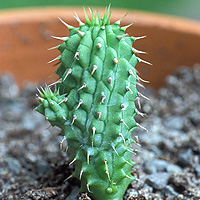Penn Herb Wellness Guide
HoodiaFind Products
 © Martin Wall
© Martin WallParts Used & Where Grown
Hoodia is a succulent plant that looks like a cactus. A member of the milkweed family, hoodia is native to the Kalahari desert in the southern tip of Africa, principally in the nations of South Africa and Namibia. The plant's latex and inner parts are used, with the spines removed.
- Reliable and relatively consistent scientific data showing a substantial health benefit.
- Contradictory, insufficient, or preliminary studies suggesting a health benefit or minimal health benefit.
- For an herb, supported by traditional use but minimal or no scientific evidence. For a supplement,little scientific support.
Our proprietary “Star-Rating” system was developed to help you easily understand the amount of scientific support behind each supplement in relation to a specific health condition. While there is no way to predict whether a vitamin, mineral, or herb will successfully treat or prevent associated health conditions, our unique ratings tell you how well these supplements are understood by the medical community, and whether studies have found them to be effective for other people.
For over a decade, our team has combed through thousands of research articles published in reputable journals. To help you make educated decisions, and to better understand controversial or confusing supplements, our medical experts have digested the science into these three easy-to-follow ratings. We hope this provides you with a helpful resource to make informed decisions towards your health and well-being.
This supplement has been used in connection with the following health conditions:
| Used for | Amount | Why |
|---|---|---|
Obesity | Unknown | Some clinical trials suggest hoodia may be effective at curbing appetite. |
Traditional Use (May Not Be Supported by Scientific Studies)
The San people, native to the Kalahari desert, have used hoodia for millennia to suppress appetite for food and water and to increase energy.1 They cut the spines off the plant and eat the inner portion and drink the white latex.
Copyright 2025 TraceGains, Inc. All rights reserved.
Learn more about TraceGains, the company.
The information presented by TraceGains is for informational purposes only. It is based on scientific studies (human, animal, or in vitro), clinical experience, or traditional usage as cited in each article. The results reported may not necessarily occur in all individuals. Self-treatment is not recommended for life-threatening conditions that require medical treatment under a doctor's care. For many of the conditions discussed, treatment with prescription or over the counter medication is also available. Consult your doctor, practitioner, and/or pharmacist for any health problem and before using any supplements or before making any changes in prescribed medications. Information expires December 2025.


